
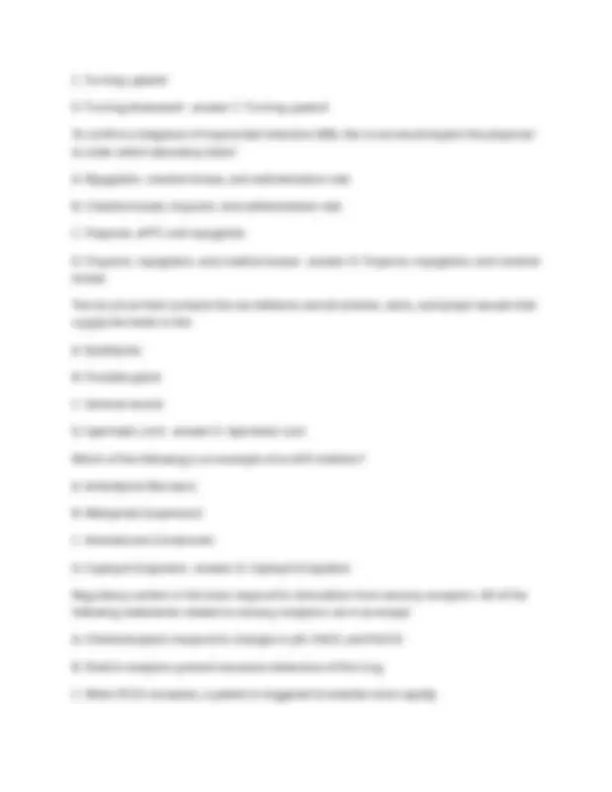
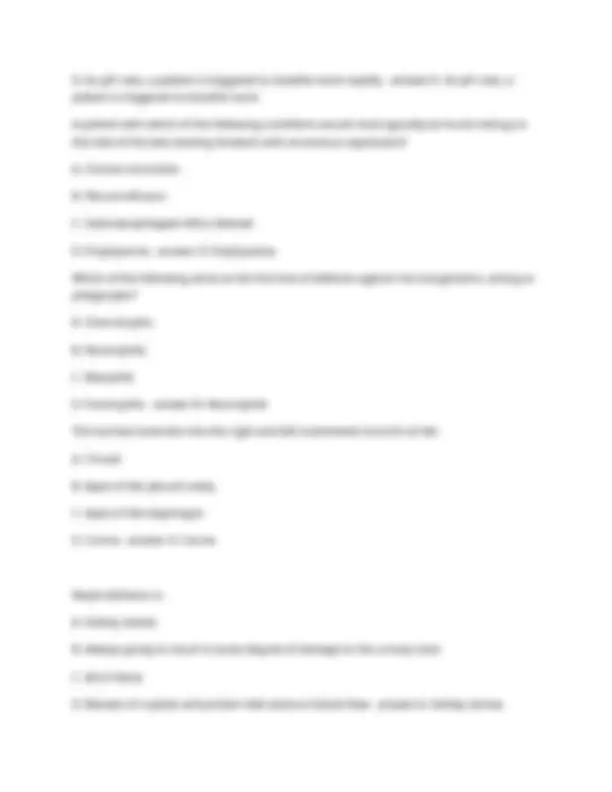
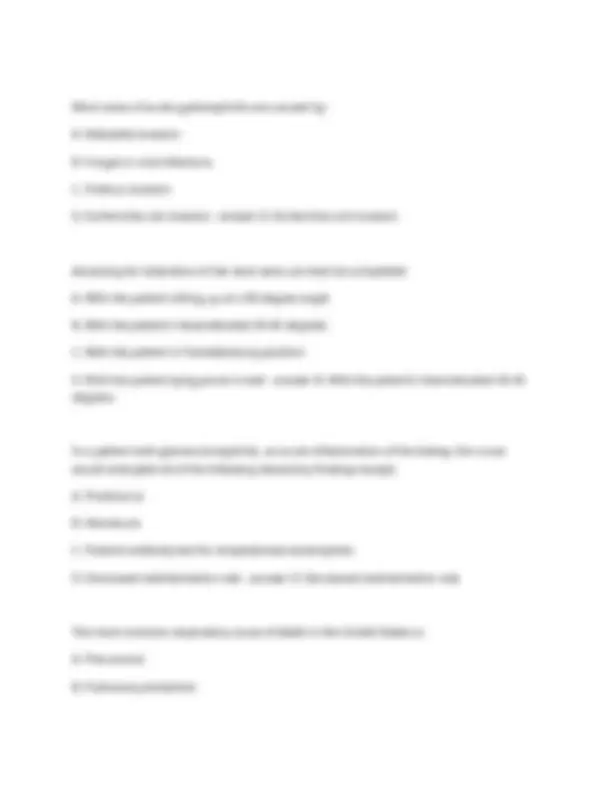
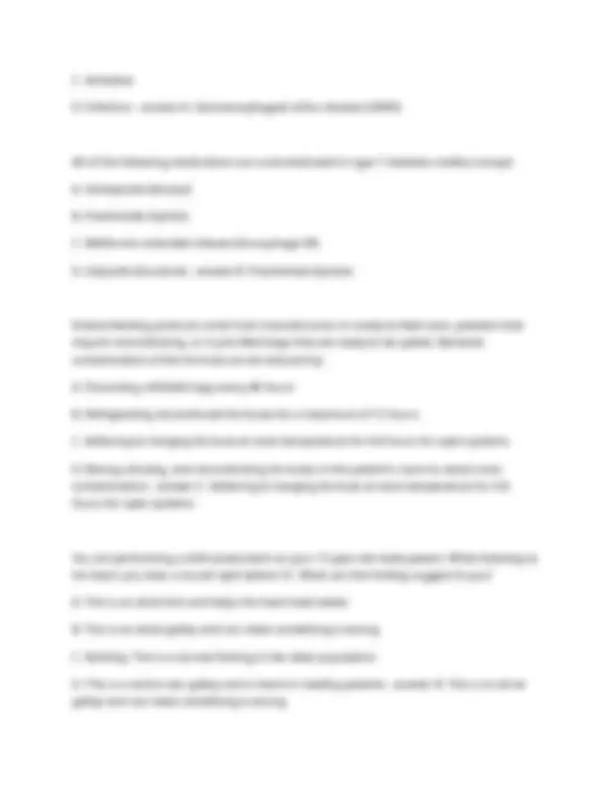
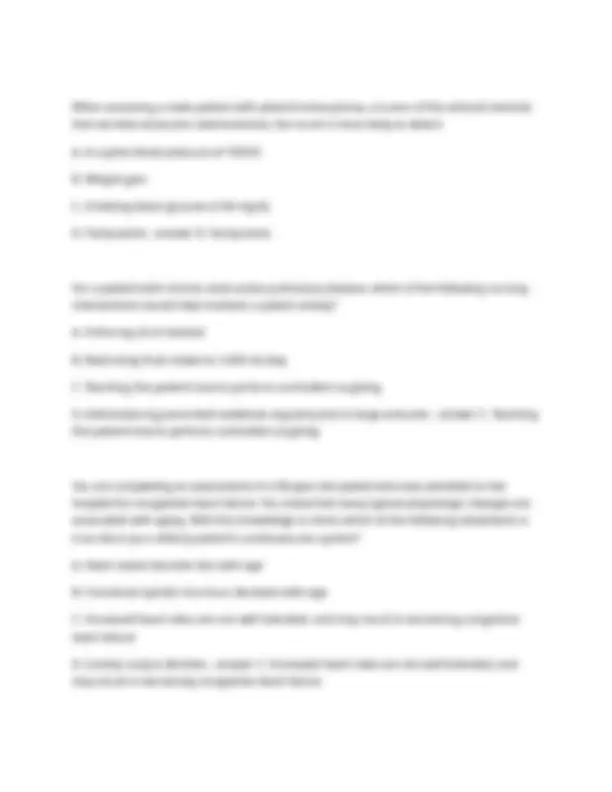


Study with the several resources on Docsity

Earn points by helping other students or get them with a premium plan


Prepare for your exams
Study with the several resources on Docsity

Earn points to download
Earn points by helping other students or get them with a premium plan
Community
Ask the community for help and clear up your study doubts
Discover the best universities in your country according to Docsity users
Free resources
Download our free guides on studying techniques, anxiety management strategies, and thesis advice from Docsity tutors
CMSRN 1 EXAM QUESTIONS AND VERIFIED ANSWERS.
Typology: Exams
1 / 9

This page cannot be seen from the preview
Don't miss anything!






You may see a slight increase in diastolic blood pressure early in shock because: A. Concurrent brain injury is present B. Stroke volume has increased C. There is an increase in vascular tone D. Left ventricular contractions have strengthened - answer C. There is an increase in vascular tone A 62-year-old male patient with a remote history of rheumatic fever is admitted to the medical-surgical unit with the following symptoms: Subjective: Shortness of breath, chest pain, syncope Objective: Peripheral edema, neck vein distension, weight gain, cyanosis, hepatomegaly, bounding pulses, cardiac arrhythmia Which of the following is most likely this patient's primary diagnosis? A. Abdominal aortic aneurysm B. Left heart failure C. Aortic valve stenosis D. Endocarditis - answer C. Aortic valve stenosis You are caring for a patient who has been admitted to the hospital with an intestinal obstruction. All of the following are appropriate nursing interventions for this patient except: A. Monitor hemodynamics closely B. Educate the patient on enteral nutrition C. Provide pain management as ordered
D. Prepare patient and family for surgical procedure and potential ostomy - answer B. Educate the patient on enteral nutrition A patient is admitted to the hospital with severe pain, guarding, and rigidity of the abdomen. Labs indicate increased levels of amylase and leukocytosis. Cullen's sign is positive (bruising around the umbilicus, indicative of intra-abdominal bleeding) and the patient is showing some signs of respiratory distress. The patient has a history of alcohol abuse. Which of the following conditions is most likely to be diagnosed? A. Alcoholic cirrhosis B. Pneumonia C. Acute liver failure D. Acute pancreatitis - answer D. Acute pancreatitis Your male patient, who has a diagnosis of chronic liver failure, has deficient vitamin K absorption. Which assessment findings indicate vitamin K deficiency? A. Testicular atrophy and gynecomastia B. Dyspnea and fatigue C. Petechiae and ecchymoses D. Ascites and orthopnea - answer C. Petechiae and ecchymoses When performing an assessment on a patient with emphysema, you find that your patient has a barrel chest. The alteration in the patient's chest is due to: A. Hyperinflation of the lungs B. Use of accessory muscles C. Chronic hypoxia D. Collapse of distal alveoli - answer A. Hyperinflation of the lungs Supination is defined as: A. Turning a part toward midline B. Turning a part away from midline
D. As pH rises, a patient is triggered to breathe more rapidly - answer D. As pH rises, a patient is triggered to breathe more A patient with which of the following conditions would most typically be found sitting on the side of the bed, leaning forward, with an anxious expression? A. Chronic bronchitis B. Pleural effusion C. Gastroesophageal reflux disease D. Emphysema - answer D. Emphysema Which of the following serve as the first line of defense against microorganisms, acting as phagocytes? A. Granulocytes B. Neutrophils C. Basophils D. Eosinophils - answer B. Neutrophils The trachea branches into the right and left mainstream bronchi at the: A. Cricoid B. Apex of the pleural cavity C. Apex of the diaphragm D. Carina - answer D. Carina Nephrolithiasis is: A. Kidney stones B. Always going to result in some degree of damage to the urinary tract C. All of these D. Masses of crystals and protein that obstruct blood flow - answer A. Kidney stones
Most cases of acute pyelonephritis are caused by: A. Klebsiella invasion B. Fungal or viral infections C. Proteus invasion D. Escherichia coli invasion - answer D. Escherichia coli invasion Assessing for distention of the neck veins can best be completed: A. With the patient sitting up at a 90-degree angle B. With the patient's head elevated 30-45 degrees C. With the patient in Trendelenburg position D. With the patient lying prone in bed - answer B. With the patient's head elevated 30- degrees In a patient with glomerulonephritis, an acute inflammation of the kidney, the nurse would anticipate all of the following laboratory findings except: A. Proteinuria B. Hematuria C. Positive antibody test for streptokinase exoenzymes D. Decreased sedimentation rate - answer D. Decreased sedimentation rate The most common respiratory cause of death in the United States is: A. Pneumonia B. Pulmonary embolism
What is the treatment for hyperparathyroidism? A. Thyroid hormone replacement therapy B. Spironolactone treatment C. Radioactive iodine (RAI) therapy D. Surgical removal of the glands - answer D. Surgical removal of the glands A nurse is caring for an elderly patient with congestive heart failure. The nurse keeps in mind that respiratory changes associated with aging include diminished effectiveness of gas exchange between alveolus and capillary walls leading to: A. Thinning of pulmonary vasculature B. An increase in pH and pCO C. Thinning of moist mucous membranes D. A decline in pO2 and O2 saturation - answer D. A decline in pO2 and O2 saturation The median age of onset of acute lymphocytic leukemia (ALL) is: A. 15 years of age B. 4 years of age C. 50 years of age D. 60 years of age - answer B. 4 years of age An esophageal obstruction is defined as any blockage of the gastrointestinal tract. What is the most common cause of this condition? A. Gastroesophageal reflux disease (GERD) B. Esophageal tumors
C. Achalasia D. Infection - answer A. Gastroesophageal reflux disease (GERD) All of the following medications are contraindicated in type 1 diabetes mellitus except: A. Glimepiride (Amaryl) B. Pramlintide (Symlin) C. Metformin extended release (Glucophage XR) D. Glipizide (Glucotrol) - answer B. Pramlintide (Symlin) Enteral feeding products come from manufacturers in ready-to-feed cans, powders that require reconstituting, or in pre-filled bags that are ready to be spiked. Bacterial contamination of the formula can be reduced by: A. Discarding refillable bags every 48 hours B. Refrigerating reconstituted formulas for a maximum of 72 hours C. Adhering to hanging formula at room temperature for 4-8 hours for open systems D. Mixing, diluting, and reconstituting formulas in the patient's room to avoid cross- contamination - answer C. Adhering to hanging formula at room temperature for 4- hours for open systems You are performing a shift assessment on your 72-year old male patient. While listening to his heart, you hear a sound right before S1. What can this finding suggest to you? A. This is an atrial kick and helps the heart beat better B. This is an atrial gallop and can mean something is wrong C. Nothing. This is a normal finding in the older population. D. This is a ventricular gallop and is heard in healthy patients - answer B. This is an atrial gallop and can mean something is wrong